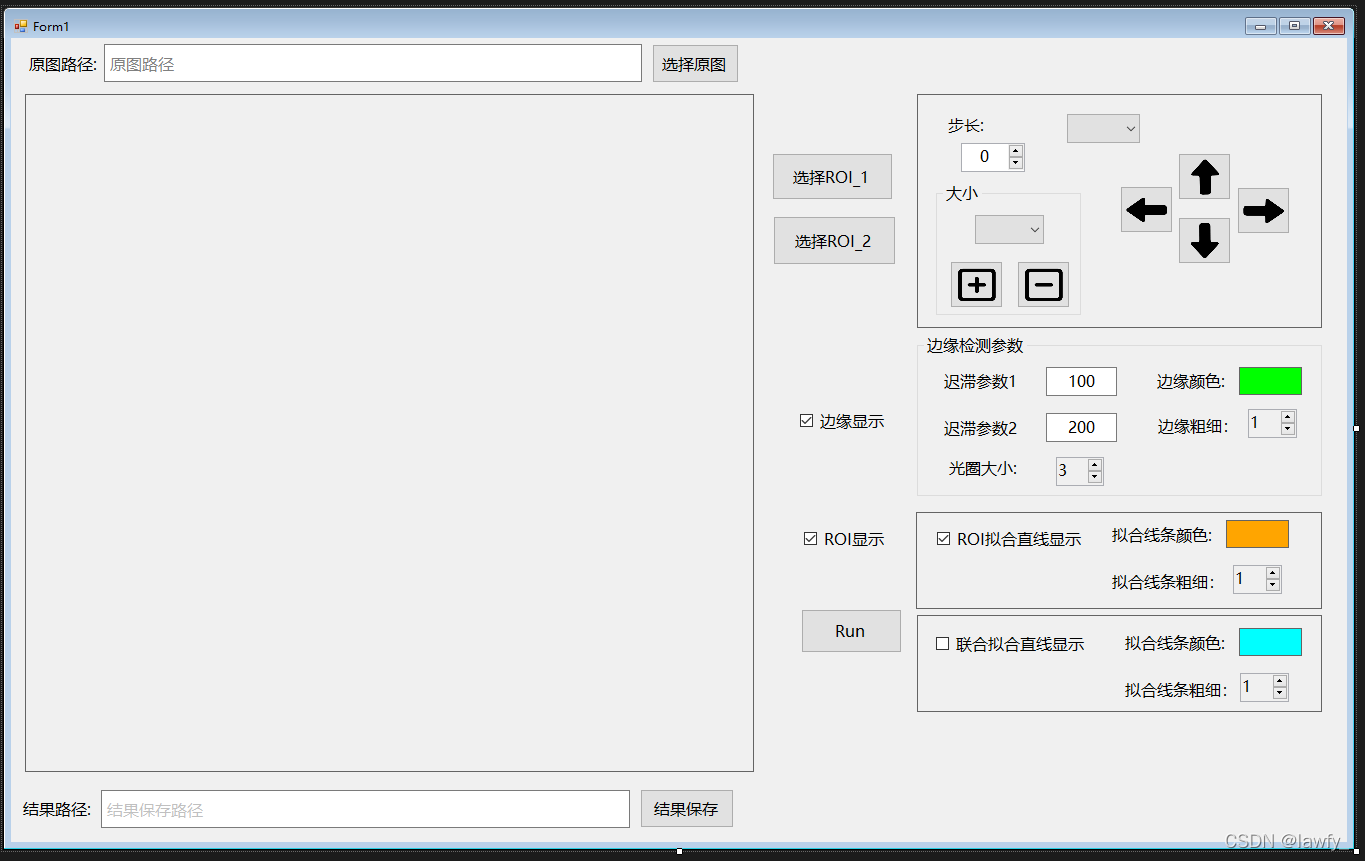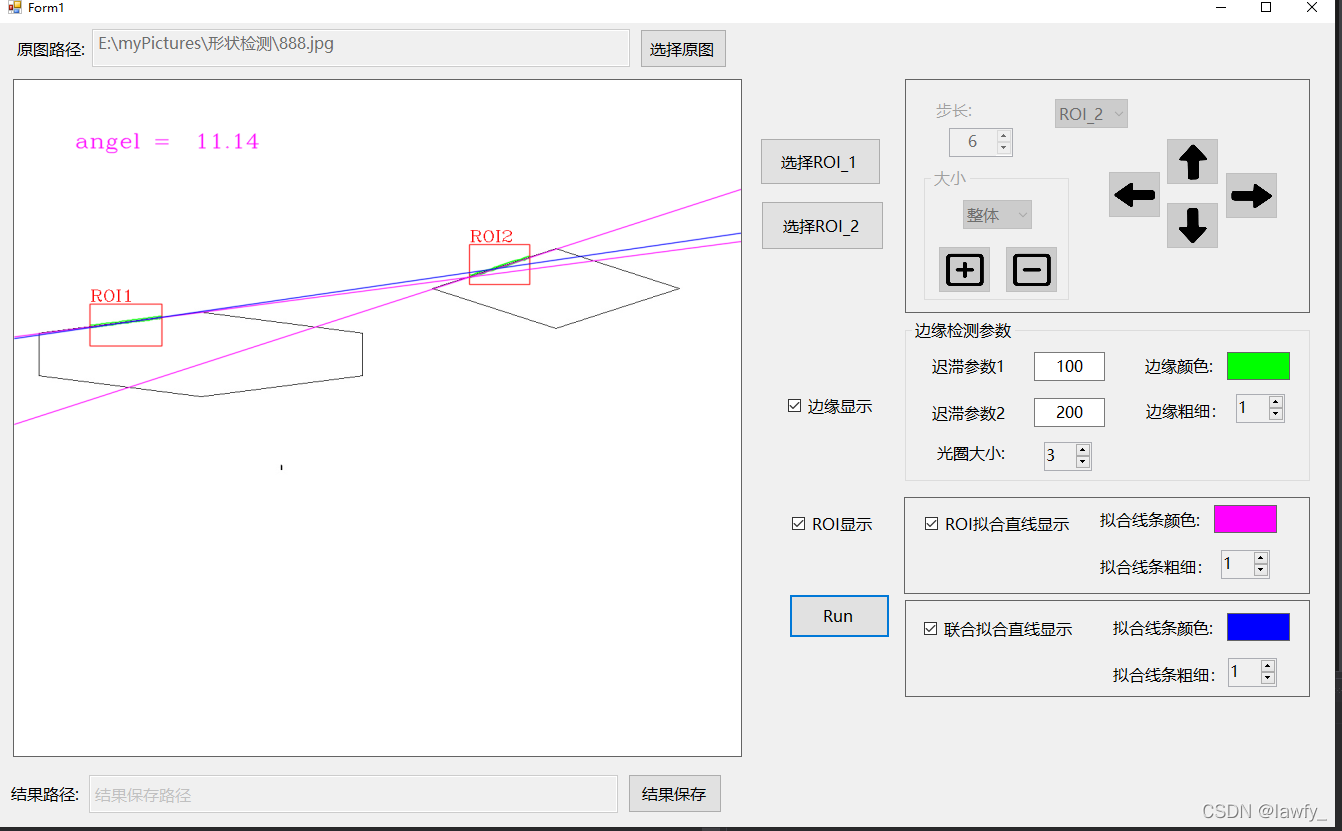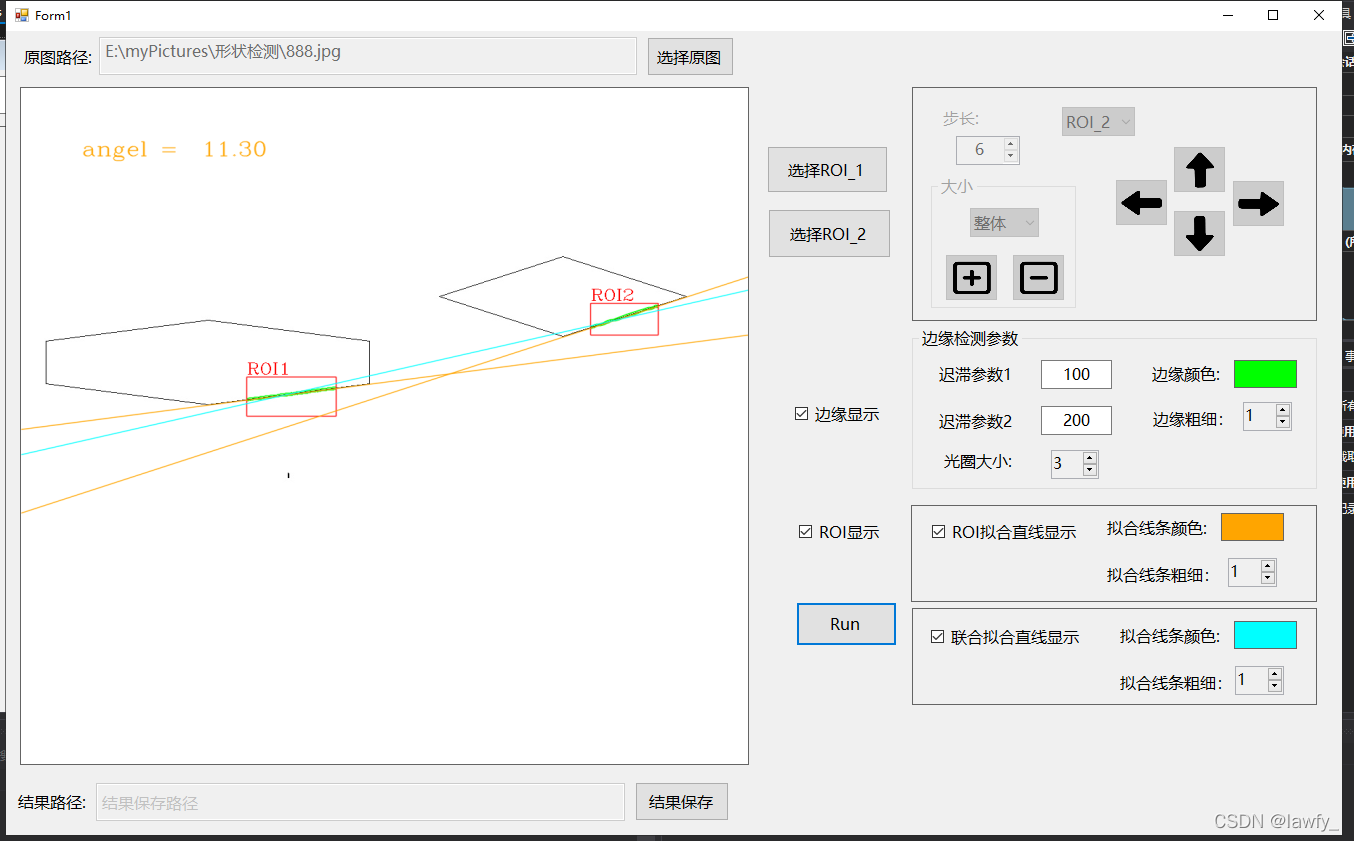c# OpencvSharp4 抓边
Iawfy_ 人气:0环境: VS2019 , OpencvSharp4 4.5.5.20211231 , .NET Framework 4.8
界面设计:

图像显示用的是picturebox 控件都是windows基本控件
效果展示:


图像是自己画图画的 所以抓的效果比较好 。其他图片的话可能需要调整一下相关参数,效果可能达不到这么好
实现原理: 在图像中选择ROI,从原图上把对应ROI部分的图像扣下来,然后对扣下来的图像进行边缘处理等操作,得到边缘和拟合线,最后在原图上将边缘和拟合线画出来即可。注意,得到的边缘是相对于ROI区域的坐标,需要转化成相对于原图的坐标才行,只需加上ROI的坐标即可。
主要部分代码:
定义的ROI类 注意一下四个点的相对位置
public class ROI
{
// 四个点的顺序关系
// 1---2
// | |
// 3---4
public OpenCvSharp.Point FirstPoint { get; set; } = new OpenCvSharp.Point(0, 0);
public OpenCvSharp.Point SecondPoint { get; set; } = new OpenCvSharp.Point(0, 0);
public OpenCvSharp.Point ThirdPoint { get; set; } = new OpenCvSharp.Point(0, 0);
public OpenCvSharp.Point FourthPoint { get; set; } = new OpenCvSharp.Point(0, 0);
public OpenCvSharp.Point2f Center
{
get
{
OpenCvSharp.Point2f center = new OpenCvSharp.Point2f();
center.X = (float)((FirstPoint.X + SecondPoint.X + ThirdPoint.X + FourthPoint.X) / 4.0);
center.Y = (float)((FirstPoint.Y + SecondPoint.Y + ThirdPoint.Y + FourthPoint.Y) / 4.0);
return center;
}
}
public OpenCvSharp.Size2f Size
{
get
{
return new OpenCvSharp.Size2f(Width, Height);
}
}
public int XLeft
{
get { return FirstPoint.X; }
}
public int YTop
{
get { return FirstPoint.Y; }
}
public int XRight
{
get { return FourthPoint.X; }
}
public int YBottom
{
get { return FourthPoint.Y; }
}
public double Width
{
get { return FourthPoint.X - FirstPoint.X; }
}
public double Height
{
get { return FourthPoint.Y - FirstPoint.Y; }
}
public void Reset()
{
FirstPoint = new OpenCvSharp.Point(0, 0);
SecondPoint = new OpenCvSharp.Point(0, 0);
ThirdPoint = new OpenCvSharp.Point(0, 0);
FourthPoint = new OpenCvSharp.Point(0, 0);
}
// 四个点全为0 则判断为空
public bool IsNull()
{
bool en = true;
en = en && FirstPoint == new OpenCvSharp.Point(0, 0);
en = en && SecondPoint == new OpenCvSharp.Point(0, 0);
en = en && ThirdPoint == new OpenCvSharp.Point(0, 0);
en = en && FourthPoint == new OpenCvSharp.Point(0, 0);
return en;
}
public OpenCvSharp.Point2f[] GetCoutonrs2f()
{
OpenCvSharp.Point2f[] coutonrs = new OpenCvSharp.Point2f[4];
coutonrs[0] = FirstPoint;
coutonrs[1] = SecondPoint;
coutonrs[2] = FourthPoint;
coutonrs[3] = ThirdPoint;
return coutonrs;
}
public OpenCvSharp.Point[] GetCoutonrs()
{
OpenCvSharp.Point[] coutonrs = new OpenCvSharp.Point[4];
coutonrs[0] = FirstPoint;
coutonrs[1] = SecondPoint;
coutonrs[2] = FourthPoint;
coutonrs[3] = ThirdPoint;
return coutonrs;
}
}相关变量:
public enum eDirections // ROI移动方向
{
NULL = 0,
上 = 1,
下 = 2,
左 = 3,
右 = 4
}
//ROI大小调整方式
public enum eResizeMode
{
All = 0, // 长宽一起调整
Width = 1, // 只变宽度 即 矩形的长
Height = 2, // 只变高度 即 矩形的宽
}
public class yVars
{
public static string OriImg; // 原图
public static bool IsDrawEdgeOK = false;
public static bool pbxMouseDown = false;
public static bool IsMouseMove = false;
public static bool IsSelectROIOK = false;
public static bool IsMouseUp = false;
public static int step; //ROI区域移动步长
public static eDirections direct = eDirections.NULL;
public static int ROINum = 1; // 操作第一个ROI还是第二个ROI
public static bool IsSelectingROI = false;
//
public static bool IsSelectROI_1 = false;
public static bool IsSelectROI_1_OK = false;
public static bool IsSelectROI_2 = false;
public static bool IsSelectROI_2_OK = false;
public static ROI myROI_1 = new ROI();
public static ROI myROI_2 = new ROI();
}ROI的绘制:
矩形的ROI ,我们只需要两个点就能确定一个矩形。
我们获取到的位置是鼠标相对于picturebox的位置,需要转化成相对于图像的坐标,我的 picturebox 的 sizemode 是 stretchImage ,所以按比例转化过去就行。
在 picturebox 的 mousedown 事件中 记录鼠标按下的第一个位置 为ROI的第一个点。
我把绘制ROI的过程写在 mousemove 事件里面,这样就能实现在确定第一个点后鼠标移动时ROI区域一直显示出来
private void pbxImgShow_MouseMove(object sender, MouseEventArgs e)
{
if (yVars.IsSelectROI_1 == false && yVars.IsSelectROI_2 == false)
return;
if (yVars.pbxMouseDown == false)
return;
if (yVars.IsMouseUp == true)
return;
int mx = 0, my = 0;
Mat mm = new Mat(yVars.OriImg);
// 鼠标相对于picturebox的位置
mx = Frm_Main.Instance.pbxImgShow.PointToClient(Control.MousePosition).X;
my = Frm_Main.Instance.pbxImgShow.PointToClient(Control.MousePosition).Y;
// 鼠标移动时 位置在 picturebox 中就画出对应的ROI形状
if (mx < pbxImgShow.Width && my < pbxImgShow.Height)
{
//转成在图片上的位置
double xx = mx * mm.Width * 1.0 / Frm_Main.Instance.pbxImgShow.Width;
double yy = my * mm.Height * 1.0 / Frm_Main.Instance.pbxImgShow.Height;
if (yVars.IsSelectROI_1 == true)
{
yVars.myROI_1.FourthPoint = new OpenCvSharp.Point(xx, yy);
yVars.myROI_1.SecondPoint = new OpenCvSharp.Point(xx, yVars.myROI_1.FirstPoint.Y);
yVars.myROI_1.ThirdPoint = new OpenCvSharp.Point(yVars.myROI_1.FirstPoint.X, yy);
mm = yActions.DrawROIMat(mm, yVars.myROI_1);
yVars.IsSelectROI_1_OK = true;
}
else if (yVars.IsSelectROI_2 == true)
{
yVars.myROI_2.FourthPoint = new OpenCvSharp.Point(xx, yy);
yVars.myROI_2.SecondPoint = new OpenCvSharp.Point(xx, yVars.myROI_2.FirstPoint.Y);
yVars.myROI_2.ThirdPoint = new OpenCvSharp.Point(yVars.myROI_2.FirstPoint.X, yy);
mm = yActions.DrawROIMat(mm, yVars.myROI_2);
yVars.IsSelectROI_2_OK = true;
}
yVars.IsMouseMove = true;
}
else // 释放鼠标时的点位不在picturebox中 将相关变量值清空
{
if (yVars.IsSelectROI_1 == true)
{
yVars.myROI_1.Reset();
yVars.IsSelectROI_1_OK = false;
}
else if (yVars.IsSelectROI_2 == true)
{
yVars.myROI_2.Reset();
yVars.IsSelectROI_2_OK = false;
}
}
pbxImgShow.Image = yImgConvert.MatToBitmap(mm);
mm.Release();
}在线程或者循环等过程中定义的 mat 要及时 Release 掉。
在 mouseup 事件中就绘制完成了 注意选择的第一点和第二点,分别是ROI的 FirstPoint 和 FourthPoint ,两点的相对位置要确定好,要保证 FirstPoint 为左上角的点 FourthPoint 为右下角的点,不是的话 就对 FirstPoint 和 FourthPoint 重新赋值, FirstPoint 为两点的 x , y 最小的点 ,FourthPoint 为两点的 x , y 最大的点。
绘制完ROI后可以对其位置和大小进行相应的调整。
public static Mat DrawROIMat(Mat src, ROI rOI, Scalar? scalar = null, int thickness = 1, LineTypes lineTypes = LineTypes.AntiAlias)
{
Scalar sc = scalar ?? Scalar.Red;
Cv2.Line(src, rOI.FirstPoint, rOI.SecondPoint, sc, thickness, lineTypes);
Cv2.Line(src, rOI.SecondPoint, rOI.FourthPoint, sc, thickness, lineTypes);
Cv2.Line(src, rOI.FourthPoint, rOI.ThirdPoint, sc, thickness, lineTypes);
Cv2.Line(src, rOI.ThirdPoint, rOI.FirstPoint, sc, thickness, lineTypes);
return src;
}对位置进行调整: 主要思想就是对ROI的四个点的坐标相应方向进行加减即可,主要超限问题即可。
public static void ImgROIMove(Mat src, out Mat dstImg, ref ROI rOI, eDirections eDirections, double step, int gap = 3)
{
dstImg = new Mat();
switch (eDirections)
{
case eDirections.NULL:
break;
case eDirections.上:
if (rOI.YTop - step <= gap)
{
rOI.ThirdPoint = new OpenCvSharp.Point(rOI.ThirdPoint.X, rOI.ThirdPoint.Y - rOI.YTop + gap);
rOI.FourthPoint = new OpenCvSharp.Point(rOI.FourthPoint.X, rOI.FourthPoint.Y - rOI.YTop + gap);
rOI.FirstPoint = new OpenCvSharp.Point(rOI.FirstPoint.X, gap);
rOI.SecondPoint = new OpenCvSharp.Point(rOI.SecondPoint.X, gap);
}
else
{
rOI.FirstPoint = new OpenCvSharp.Point(rOI.FirstPoint.X, rOI.FirstPoint.Y - step);
rOI.SecondPoint = new OpenCvSharp.Point(rOI.SecondPoint.X, rOI.SecondPoint.Y - step);
rOI.ThirdPoint = new OpenCvSharp.Point(rOI.ThirdPoint.X, rOI.ThirdPoint.Y - step);
rOI.FourthPoint = new OpenCvSharp.Point(rOI.FourthPoint.X, rOI.FourthPoint.Y - step);
}
break;
case eDirections.下:
if (rOI.YBottom + step >= src.Height - gap)
{
rOI.FirstPoint = new OpenCvSharp.Point(rOI.FirstPoint.X, rOI.FirstPoint.Y + src.Height - rOI.YBottom - gap);
rOI.SecondPoint = new OpenCvSharp.Point(rOI.SecondPoint.X, rOI.SecondPoint.Y + src.Height - rOI.YBottom - gap);
rOI.ThirdPoint = new OpenCvSharp.Point(rOI.ThirdPoint.X, src.Height - gap);
rOI.FourthPoint = new OpenCvSharp.Point(rOI.FourthPoint.X, src.Height - gap);
}
else
{
rOI.FirstPoint = new OpenCvSharp.Point(rOI.FirstPoint.X, rOI.FirstPoint.Y + step);
rOI.SecondPoint = new OpenCvSharp.Point(rOI.SecondPoint.X, rOI.SecondPoint.Y + step);
rOI.ThirdPoint = new OpenCvSharp.Point(rOI.ThirdPoint.X, rOI.ThirdPoint.Y + step);
rOI.FourthPoint = new OpenCvSharp.Point(rOI.FourthPoint.X, rOI.FourthPoint.Y + step);
}
break;
case eDirections.左:
if (rOI.XLeft - step <= gap)
{
rOI.SecondPoint = new OpenCvSharp.Point(rOI.SecondPoint.X - rOI.XLeft + gap, rOI.SecondPoint.Y);
rOI.FourthPoint = new OpenCvSharp.Point(rOI.FourthPoint.X - rOI.XLeft + gap, rOI.FourthPoint.Y);
rOI.ThirdPoint = new OpenCvSharp.Point(gap, rOI.ThirdPoint.Y);
rOI.FirstPoint = new OpenCvSharp.Point(gap, rOI.FirstPoint.Y);
}
else
{
rOI.FirstPoint = new OpenCvSharp.Point(rOI.FirstPoint.X - step, rOI.FirstPoint.Y);
rOI.SecondPoint = new OpenCvSharp.Point(rOI.SecondPoint.X - step, rOI.SecondPoint.Y);
rOI.ThirdPoint = new OpenCvSharp.Point(rOI.ThirdPoint.X - step, rOI.ThirdPoint.Y);
rOI.FourthPoint = new OpenCvSharp.Point(rOI.FourthPoint.X - step, rOI.FourthPoint.Y);
}
break;
case eDirections.右:
if (rOI.XRight + step >= src.Width - gap)
{
rOI.FirstPoint = new OpenCvSharp.Point(rOI.FirstPoint.X + src.Width - rOI.XRight - gap, rOI.FirstPoint.Y);
rOI.ThirdPoint = new OpenCvSharp.Point(rOI.ThirdPoint.X + src.Width - rOI.XRight - gap, rOI.ThirdPoint.Y);
rOI.FourthPoint = new OpenCvSharp.Point(src.Width - gap, rOI.FourthPoint.Y);
rOI.SecondPoint = new OpenCvSharp.Point(src.Width - gap, rOI.SecondPoint.Y);
}
else
{
rOI.FirstPoint = new OpenCvSharp.Point(rOI.FirstPoint.X + step, rOI.FirstPoint.Y);
rOI.SecondPoint = new OpenCvSharp.Point(rOI.SecondPoint.X + step, rOI.SecondPoint.Y);
rOI.ThirdPoint = new OpenCvSharp.Point(rOI.ThirdPoint.X + step, rOI.ThirdPoint.Y);
rOI.FourthPoint = new OpenCvSharp.Point(rOI.FourthPoint.X + step, rOI.FourthPoint.Y);
}
break;
default:
break;
}
dstImg = yActions.DrawROIMat(src, rOI);
}对大小进行调整: 主要思路是 ROI 大小调整前后,其中心点坐标不变,相应的长度和宽度变了。我们就可以采用 OpenCvSharp.RotatedRect 这个类,根据 中心点坐标,相应size,和倾斜角度(正矩形为0). 最后再把 RotatedRect 的四个顶点重新赋值给 ROI的四个顶点就好,注意一下点的相对位置关系。
public static void ImgROIResize(Mat src, out Mat dstImg, ref ROI rOI, bool IsAdd, double step, eResizeMode eResizeMode)
{
dstImg = new Mat();
double height = rOI.Height, width = rOI.Width;
if (IsAdd == true)
{
switch (eResizeMode)
{
case eResizeMode.All:
height = rOI.Height + step;
width = rOI.Width + step;
break;
case eResizeMode.Width:
width = rOI.Width + step;
break;
case eResizeMode.Height:
height = rOI.Height + step;
break;
}
}
else
{
switch (eResizeMode)
{
case eResizeMode.All:
height = rOI.Height - step;
width = rOI.Width - step;
break;
case eResizeMode.Width:
width = rOI.Width - step;
break;
case eResizeMode.Height:
height = rOI.Height - step;
break;
}
}
OpenCvSharp.Size2f size = new Size2f(width, height);
OpenCvSharp.RotatedRect rotateRect = new RotatedRect(rOI.Center, size, 0);
Point2f[] points = rotateRect.Points();// 获得矩形四个顶点坐标
// 大小缩放后需要判断坐标是否超限
for (int i = 0; i < points.Length; i++)
{
if (points[i].X <= 0 || points[i].Y <= 0 || points[i].X >= src.Width || points[i].Y >= src.Height)
{
return;
}
}
rOI.FirstPoint = new OpenCvSharp.Point(points[1].X, points[1].Y);
rOI.SecondPoint = new OpenCvSharp.Point(points[2].X, points[2].Y);
rOI.ThirdPoint = new OpenCvSharp.Point(points[0].X, points[0].Y);
rOI.FourthPoint = new OpenCvSharp.Point(points[3].X, points[3].Y);
dstImg = yActions.DrawROIMat(src, rOI);
}绘制并调整好ROI后,从原图上将对应的ROI图像扣下来,
public static Mat GetROIMat(Mat mm, ROI rOI)
{
Mat mask = Mat.Zeros(mm.Size(), MatType.CV_8UC1);
List<List<OpenCvSharp.Point>> pp = new List<List<OpenCvSharp.Point>>() {
rOI.GetCoutonrs().ToList()
};
Cv2.FillPoly(mask, pp, new Scalar(255, 255, 255));
OpenCvSharp.Rect rect = Cv2.BoundingRect(rOI.GetCoutonrs2f());
if (rect.X <= 0) rect.X = 1;
if (rect.Y <= 0) rect.Y = 0;
if (rect.X + rect.Width > mm.Width)
rect.Width = mm.Width - rect.X - 1;
if (rect.Y + rect.Height > mm.Height)
rect.Height = mm.Height - rect.Y - 1;
Mat src = new Mat(mm, rect);
Mat maskROI = new Mat(mask, rect);
Mat dstImg = new Mat();
Cv2.BitwiseAnd(src, src, dstImg, maskROI);
return dstImg;
}然后对每张扣下来的mat进行边缘检测 抓边拟合等操作
部分代码
coutonrs = yVars.myROI_1.GetCoutonrs2f();
srcROIImg = yActions.GetROIMat(src, yVars.myROI_1);
Cv2.CvtColor(srcROIImg, grayImg, ColorConversionCodes.RGB2GRAY);
Cv2.Blur(grayImg, grayImg, new OpenCvSharp.Size(3, 3));
Cv2.Canny(grayImg, cannyImg, param1, param2, param3, true);
//获得轮廓
Cv2.FindContours(cannyImg, out contoursROI1, out hierarchly, RetrievalModes.Tree, ContourApproximationModes.ApproxSimple, new OpenCvSharp.Point(0, 0));
if (contoursROI1.Length == 0)
{
YXH._01.yMessagebox.ShowDialogCN("ROI_1未抓到边,请调整迟滞参数,或重新选择ROI区域");
return;
}
// 获取轮廓后需要将点的坐标转换到原图上 此时的坐标是相对于ROI区域的坐标
// 即每个坐标需要加上ROI区域的左上角坐标 再将转化后的坐标添加进拟合集合内
for (int i = 0; i < contoursROI1.Length; i++)
{
for (int j = 0; j < contoursROI1[i].Length; j++)
{
contoursROI1[i][j] += yVars.myROI_1.FirstPoint;
ROI_1_Points.Add(contoursROI1[i][j]);
AllPoints.Add(contoursROI1[i][j]);
}
}操作完成后再根据想要在界面上显示的进行相应的绘制即可。
加载全部内容